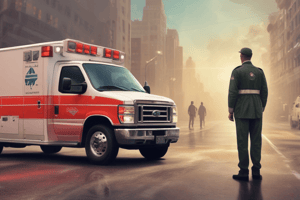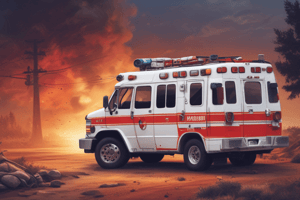Podcast
Questions and Answers
What is the primary purpose of Personal Protective Equipment (PPE) in emergency care?
What is the primary purpose of Personal Protective Equipment (PPE) in emergency care?
- To aid in the transportation of medical equipment
- To facilitate communication with other responders
- To protect healthcare providers from exposure to diseases (correct)
- To enable healthcare providers to respond rapidly to patients
Which of the following is NOT a key challenge in emergency care?
Which of the following is NOT a key challenge in emergency care?
- Limited information
- Advanced healthcare technologies (correct)
- Time constraints
- Public access and safety concerns
Why is effective communication critical among different agencies in emergency care?
Why is effective communication critical among different agencies in emergency care?
- To control public access to health services
- To limit the number of personnel involved
- To ensure optimal responses for patients (correct)
- To reduce the need for medical equipment
What aspect of patient care must emergency services adapt to?
What aspect of patient care must emergency services adapt to?
What is a crucial function of communication devices in emergency situations?
What is a crucial function of communication devices in emergency situations?
What is the primary goal of emergency care?
What is the primary goal of emergency care?
Which assessment focuses on identifying life-threatening conditions?
Which assessment focuses on identifying life-threatening conditions?
What is a main component of the secondary assessment?
What is a main component of the secondary assessment?
Which principle emphasizes teamwork among emergency medical personnel?
Which principle emphasizes teamwork among emergency medical personnel?
What type of emergency situation includes injuries caused by accidents?
What type of emergency situation includes injuries caused by accidents?
Which of the following is NOT considered a type of emergency situation?
Which of the following is NOT considered a type of emergency situation?
What role does the Emergency Medical Vehicle (EMV) play in emergency care?
What role does the Emergency Medical Vehicle (EMV) play in emergency care?
Which principle of emergency care focuses on reducing delays for critical patients?
Which principle of emergency care focuses on reducing delays for critical patients?
Flashcards
Emergency Care
Emergency Care
The immediate medical care given to patients facing sudden and unexpected health issues, prioritizing stabilization and preventing further deterioration before definitive care can be administered.
Scene Assessment
Scene Assessment
Evaluating the safety of the environment for both the patient and responders, ensuring a secure and safe situation for treatment.
Primary Assessment
Primary Assessment
A quick evaluation aimed at identifying immediately life-threatening conditions like airway obstruction, breathing problems, and circulatory issues, abbreviated as ABC's (Airway, Breathing, Circulation).
Secondary Assessment
Secondary Assessment
Signup and view all the flashcards
Interventions
Interventions
Signup and view all the flashcards
Patient Transport
Patient Transport
Signup and view all the flashcards
Prioritization
Prioritization
Signup and view all the flashcards
Rapid Response
Rapid Response
Signup and view all the flashcards
Medical Equipment
Medical Equipment
Signup and view all the flashcards
Communication Devices
Communication Devices
Signup and view all the flashcards
Personal Protective Equipment (PPE)
Personal Protective Equipment (PPE)
Signup and view all the flashcards
Limited Information
Limited Information
Signup and view all the flashcards
Time Constraints
Time Constraints
Signup and view all the flashcards
Study Notes
Emergency Care Overview
- Emergency care is the immediate medical attention given to patients experiencing a sudden, unexpected illness or injury.
- The primary goal is to stabilize the patient and prevent further deterioration before definitive care can be administered.
- Emergency care involves a rapid assessment of the patient's condition, immediate interventions, and potentially life-saving measures.
- Paramedics, emergency room physicians, and other healthcare professionals play critical roles in providing emergency care.
Key Components of Emergency Care
- Scene assessment: Evaluating the safety of the environment for both the patient and responders.
- Primary assessment: Rapidly identifying life-threatening conditions like airway obstruction, breathing problems, and circulatory issues (ABCs).
- Secondary assessment: A comprehensive evaluation of the patient's medical history, current symptoms, and injuries.
- Interventions: Implementing appropriate measures immediately, including administering medications, performing procedures like CPR or advanced life support, and immobilizing injuries.
- Patient transport: Safe and efficient transfer of the patient to a more appropriate facility, often using specialized vehicles.
Key Principles of Emergency Care
- Prioritization: Recognizing and addressing life-threatening conditions first.
- Rapid response: Minimizing delays in administering care to critical patients.
- Teamwork: Effective collaboration among emergency medical personnel and other healthcare professionals.
- Evidence-based practice: Applying current knowledge and guidelines for accurate diagnosis and treatment.
- Patient-centered care: Considering the patient's needs, concerns, and preferences, to the extent possible given the urgency of the situation.
Types of Emergency Situations
- Trauma: Injuries caused by accidents, violence, or other events.
- Medical emergencies: Sudden illnesses like heart attacks, strokes, seizures, or allergic reactions.
- Behavioral health emergencies: Crises relating to mental health conditions requiring urgent care.
- Child emergencies: Addressing specialized situations unique to children, such as choking risks, specific injuries, and possible poisoning.
Equipment Used in Emergency Care
- Emergency Medical Vehicle (EMV): Mobile units for transporting patients to hospitals.
- Medical equipment: Including, but not limited to, oxygen tanks, defibrillators, and specialized medical tools.
- Communication devices: For coordinating with other responders, transmitting information, and receiving assistance.
- Personal Protective Equipment (PPE): To protect healthcare providers from potential exposure to contagious diseases and biohazards.
Key Challenges in Emergency Care
- Limited information: Assessment often must occur based on quickly gathered information from patients or bystanders.
- Time constraints: Many emergency situations demand rapid responses and immediate actions.
- Varied patient conditions: Emergency care must adapt to the multitude of different illnesses and injuries seen.
- Public access and safety concerns: Ensuring safety for emergency medical personnel while managing situations potentially involving public safety risk.
- Coordination and integration among different agencies: Effective communication and collaboration among multiple entities to ensure optimal responses for patients.
Studying That Suits You
Use AI to generate personalized quizzes and flashcards to suit your learning preferences.



